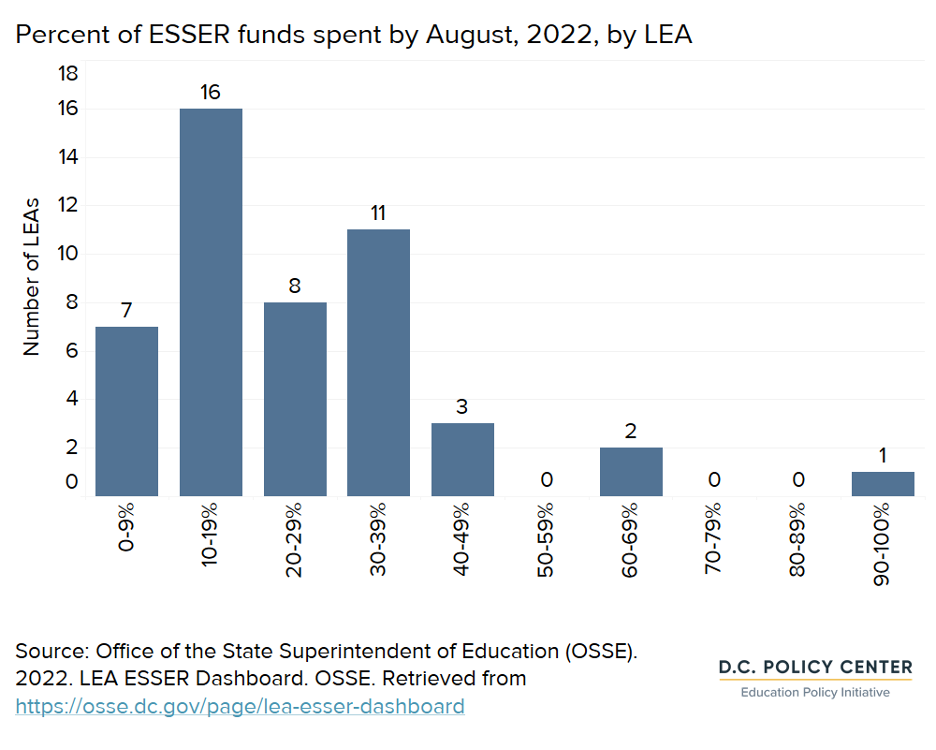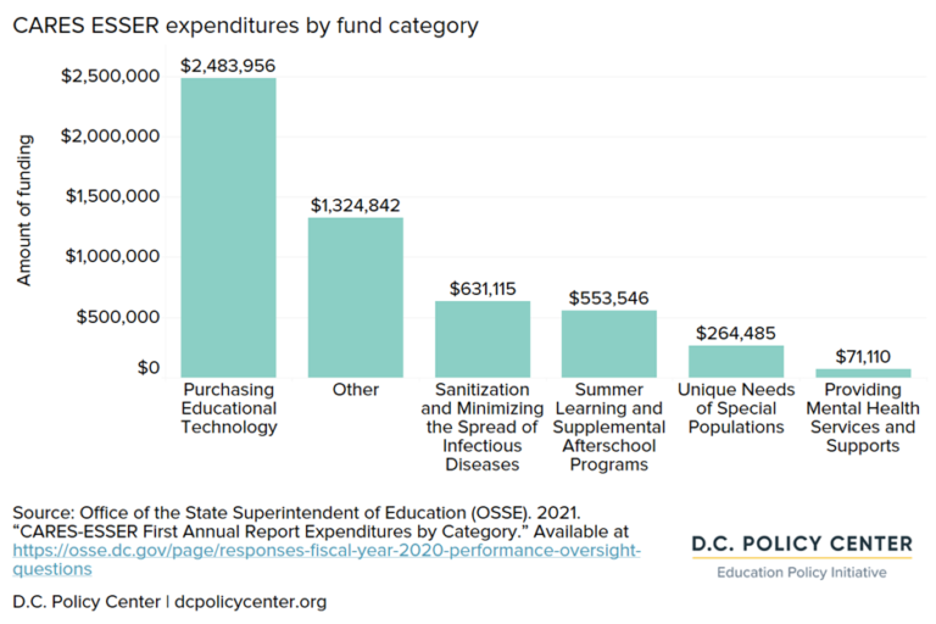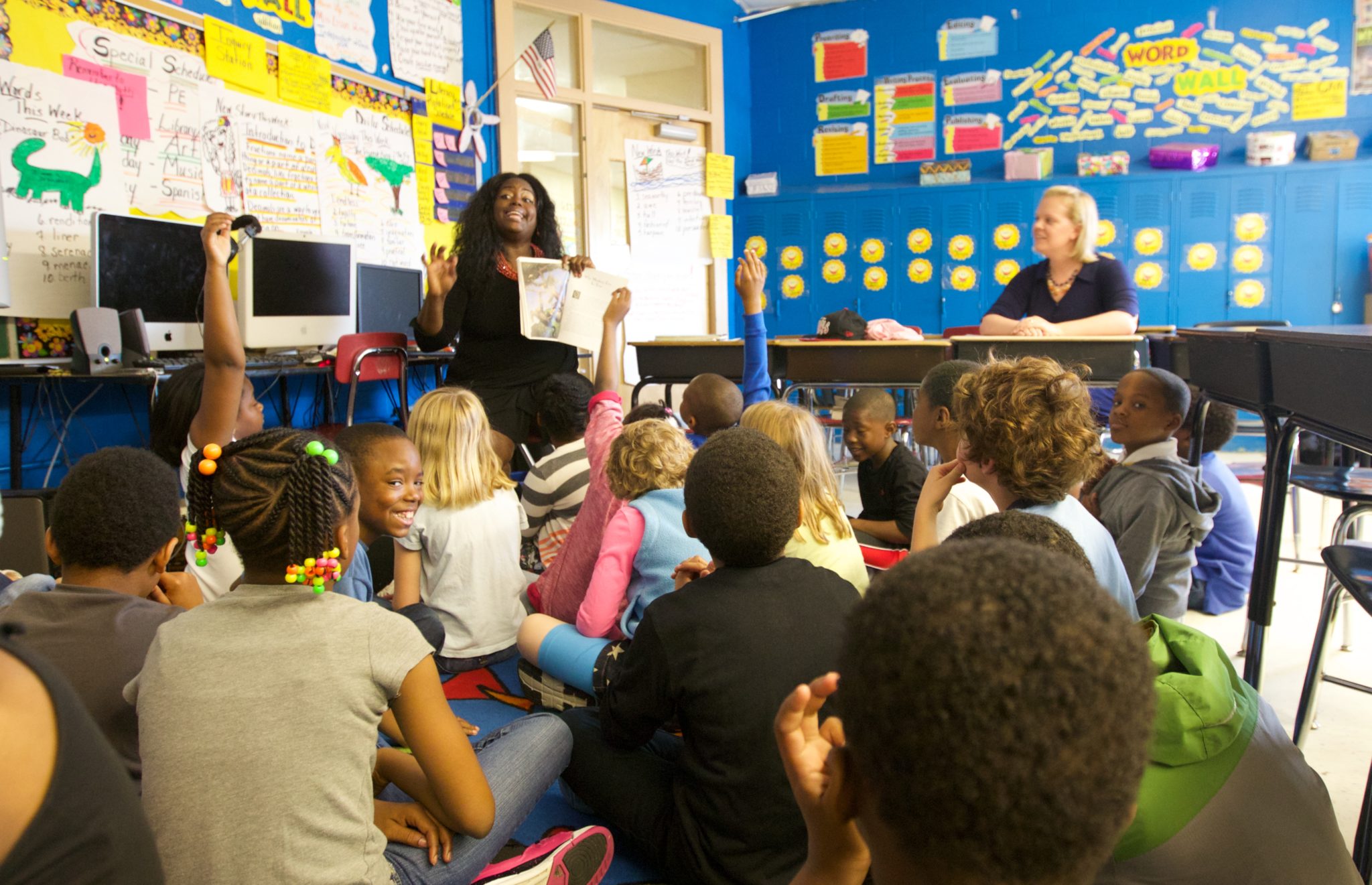

On Wednesday, September 21, 2022, Education Policy Initiative Director Chelsea Coffin testified at the D.C. State Board of Education public meeting, regarding ESSER funds and the future of school finance in D.C. You can read her testimony below, or download a PDF copy.
Good evening, members of the DC State Board of Education (SBOE). My name is Chelsea Coffin and I am the Director of the Education Policy Initiative at the D.C. Policy Center, an independent think tank focused on advancing policies for a growing and vibrant economy in D.C. This evening, I am discussing what we know about how ESSER funds have been spent in D.C. and what this could mean for the future of school finance.
The three rounds of ESSER funding mean $540 million allocated to schools to be spent by the end of fiscal year 2024 (September 30, 2024). This means approximately $1,307 in additional funding per student across five school years between 2019-20 and 2023-24 for the 48 LEAs receiving ESSER funds, assuming constant enrollment from last school year. ESSER funds are therefore about 10 percent the size of the foundation level of funding per pupil for school year 2022-23, making it important to take stock of how these funds are spent along the way and what may happen when funds expire.
I will focus on four main points:
- 80 percent of the funds have not been spent yet, with two out of five years to go in eligibility (some funds may have to be spent in a certain way, however).
- Most of the funds have been spent on learning acceleration, which is consistent over time, but we don’t know the details by activity.
- There is some variation by LEA in the amount spent and focus on learning acceleration, and more detailed data by school would be helpful.
- Some schools rely more on new sources of federal money than others, which will have implications for school budgets when the funding expires.
Moving on to how much has been spent, as of August of 2022, $113.5 million of the ESSER funds have been spent, or 21 percent of the total. This is after three fiscal years of having these funds available, with the largest of all (ESSER III) having the most time available for spending and a short period to begin in school year 2019-20. There is variation in the percent spent by LEA, with most LEAs having spent between 10 to 39 percent of their funds. However, seven LEAs have spent less than 10 percent and six LEAs have spent 40 percent or more, meaning that LEAs have varying degrees of access to future funds.


Looking at how the funds have been spent, the majority of ESSER funds (76 percent) has been spent on accelerated learning. This includes a lot of activities, such as access to technology, assessments, extended day or school year, tutoring, supports for students with disabilities and English learners, and human capital (including professional development). Other categories for spending include safe reopening and student/staff wellness. It would be great to have more detail on spending by activity to find out which investments have been more effective, but this information is not currently available. For larger LEAs, it would also be helpful to have a breakdown by school to evaluate initiatives.
| ESSER spending category | Total | Percent |
| Accelerated Learning | $ 85,754,924 | 76% |
| Safe Reopening | $ 19,503,302 | 17% |
| Other Expenditures | $ 4,491,883 | 4% |
| Student and Staff Wellness | $ 3,756,625 | 3% |
| Total | $ 113,506,734 | 100% |
This focus on learning acceleration is aligned with first round of reporting on spending between March and September of 2020. During this time, 50 percent of ESSER funds were spent on technology. Extended day and special populations represented large categories of spending as well. All of these are included as current activities for learning acceleration.


There is also a lot of variation by LEA on the percent allocated to learning acceleration. Nineteen out of 48 LEAs spent more than the average of 76 percent on learning acceleration. Fifteen out of 48 spent less than half on learning acceleration, focusing instead on safe reopening or student and staff wellness. For context, 20 percent of ESSER II funds must be spent to address learning loss. It would be interesting to see the extent to which a focus on learning acceleration is related to greater gains.


Learning acceleration in terms of instructional changes could mean a lot of different things. In school year 2021-22 to accelerate learning, at least half of LEAs planned to adjust schedules, provide after school programming, offer summer programming, deliver high dosage tutoring, offer a new intervention or support, use staff planning time in new ways for accelerated learning, offer new professional development for staff on accelerated learning, and provide additional staffing. In school year 2022-23 to accelerate learning at least half of LEAs plan to adjust scheduling with summer programming or hire additional staff. With more detailed information on how learning acceleration was spent, it would be useful for future planning to see which approaches have been more successful.
All of this analysis takes stock of LEA-level spending, and the only information at the school level looks at total federal spending from school year 2018-19 to school year 2020-21. During this time, federal spending at the school level per student increased from 9.7 percent to 12.5 percent of total per student spending, or 2.8 percentage points.However, some schools have come to rely more on federal funds, with 13 percent of schools having an increase of double this amount.
Thank you for the opportunity to testify. I look forward to answering any questions that you may have.
